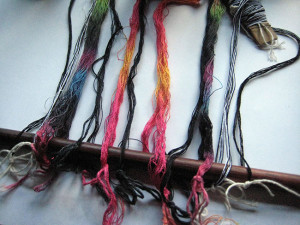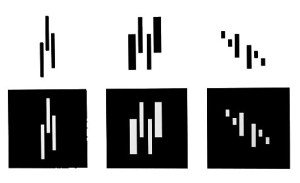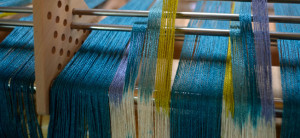We weavers can spend alot of time getting threads to behave. Not to let them run away, tangle or stretch out of tension. We tame them, or try to, so we can create with them. We want them to do things that they are sometimes reluctant to. Ikat (Kasuri) weaving has the same objective and this little warp shifting device can deliberately shift the positions of warp threads which have been ikat tied and dyed to form a pattern. You still need to work with the threads to get what you want but it is all quite magical.
The value of this little tool is that it is specifically designed for the types of looms we often use – as opposed to the back strap loom where much warp ikat cloth is created. It can be used to achieve quite detailed patterns.

Similar less precise shifting can be done without a shifter by tying sections of the warp at the back beam before beaming. I have found this to be very effective for my designs but it is less precise. It also requires warping from back to front and preferably with the warp loops threaded through the back rod.
The warp shifter tool works really well and it meant for higher precision and finer threads in designing balanced weaves. Here is a lovely video of a weaving studio in Japan which is using the warp shifter. This type of shifter is one that is used at Kawashima Textile School in Kyoto. Their Kasuri courses cover this type of warp kasuri and just a study of how the patterns can be developed from quite simple tying and dyeing of the warp is fascinating.

You can see here a lovely black and white graphic which shows a shifted warp design plan. This is from a page in one of the fantastic four volumes on Okinawan Kasuri – Textiles Across the Seas. One of the volumes is completely devoted to the designs in this format. Very strangely, these types of graphics do something to me inside and I just delight at looking through them – imagining myself creating such beautiful lines with dye, thread and weave. These volumes are published by the Textiles Across the Seas Executive Committee as a way of celebrating the ingenuity and skills of the weavers, and to keep the traditions alive and viable in our world. In the volumes I read that ‘craft is not art‘ – it must sell and circulate in a society. Craft needs to build skills and innovation within specific parameters. Business and sales are important and this has previously been strongly related to social organisation and perhaps ritual requirements. I know craft can be art but what do you think? In Australia craft of all kinds are practiced but the desire or perceived need for inclusion in wider, mainstream type training has diminished substantially.



Leave a Reply